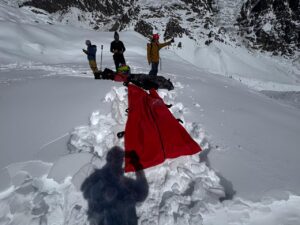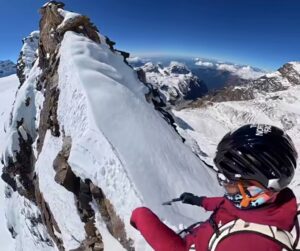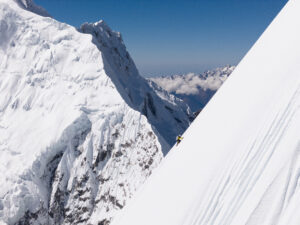A summit push on the 10th highest and one of the most dangerous mountains in the world, 8,091m Annapurna, is about to begin.
Until now, Annapurna has had 365 ascents, including 217 without bottled oxygen. At the same time, 72 people have lost their lives on this peak, most recently Wui Kin Chin, who died of Acute Mountain Sickness at 7,550m on May 23, 2019.
The single greatest danger on Annapurna is avalanches. Among the 72 deaths, 37 came from avalanches. None recently, however. An avalanche fatality last occurred on October 7, 2012. Ilyas Tukhvatullin and Ivan Lobanov, two non-O2 climbers from Uzbekistan, were swept away at 5,700m.

Avalanche on Annapurna a couple of days ago. Screenshot from a video by Breeze Sharma
2021’s unprecedented success
Annapurna’s famously high death rate dropped statistically last spring. In a single day, on April 16, 67 people summited and returned safely, including six without supplemental oxygen.
This was not as straightforward as it sounds. Some readers might recall that the Sherpas ran out of rope during the summit push, with the clients close behind. Everyone had to retreat to Camp 4, drawing on the limited oxygen stores, until a helicopter shuttled more rope and oxygen to this high camp. Without helicopters, very few, if any, would have reached the top.

Annapurna Base Camp. Photo: Seven Summit Treks
According to Nepal’s Department Of Tourism, as of today, 26 foreign climbers in four teams have permits for Annapurna I. This includes 12 women and 14 men.
The four teams about to begin their push are: 8K Expeditions, with 6 clients and 9 Sherpa guides; Seven Summit Treks with 12 clients plus Sherpas; and an Indian team with 6 clients and 6 Sherpas.
Several climbers will try to climb without O2. Juan Pablo Sarjanovich said today that on the SST team, only 4 climbers out of 12 will have personal Sherpas and O2.
As we previously reported, the climbers finished acclimatizing up to Camp 2 last week. The ones climbing on oxygen should be ready.

Climbers about to start the summit push. Photo: Juan Pablo Sarjanovich
Sherpas have left Base Camp
The Sherpas with Seven Summit Treks are leading the rope fixing. Four days ago, they still had to fix 100m of rope before Camp 3.
SST Sherpas, along with some from other teams, left Base Camp for Camp 2 today. From there, they will continue fixing this most dangerous part of the route to Camp 3.

Some of the 8K Expeditions Sherpas. Photo: 8K Expeditions
The plan is to finish setting up Camp 3 either tomorrow April 16 or Sunday, April 17. Most clients have slept two nights at 5,000m and two nights at 5,500m, according to Argentine climber Juan Pablo Sarjanovich. He confirms that most of his fellow climbers in Base Camp want to go up without O2. These no-O2 climbers have likely not acclimatized enough yet. No one has been above 6,000m.
With or without oxygen, Sarjanovich himself won’t be one of the climbers on the mountain. On April 5, he decided to abort this Annapurna climb after witnessing an avalanche along the route.
“I found myself with no reason to go on, no motivation to risk my life, no spirit to continue worrying those who want me back down,” he said.

Annapurna. Photo: Juan Pablo Sarjanovich
Action begins tomorrow
8K Expeditions announced today that they are planning their final summit push for April 19, weather permitting.
Tomorrow, April 16, both clients and guides leave Base Camp for Camp 2, to begin their summit push. The climbers with Seven Summit Treks and the Indian team will likely join them.
Grace Tseng of Taiwan is the only client on her team. Her tent lies apart from those of the rest of the climbers. She likewise is following her own schedule and has not posted anything yet. Tseng has done five 8,000ers so far. Immediately after Annapurna, she intends to climb Makalu.

Dry, cold weather awaits the climbers and their guides. Photo: Juan Pablo Sarjanovich
Three days ago, Breeze Sharma, a member of the Indian team, reported an avalanche along the route that buried some of the equipment belonging to the Sherpas on the Indian team. The other agencies could not confirm this, but Juan Pablo Sarjanovich has since done so. He notes that a falling serac triggered the avalanche.

Acclimatization rounds to C2 have ended. Photo: Moeses Fiamoncini
Much colder in April
Sarjanovich also reports that the mountain is as dry as ever. Night temperatures at Base Camp are about -3˚C, while temperatures at the summit are expected to be a chilly -33˚ to -36˚C. In other words, much colder than when the summit push occurs in May.

Trifish Chan. Photo: Trifish Chan
As noted earlier, Allie Pepper of Australia and Trifish Chan of Taiwan intend to climb without O2. Adriana Brownlee, who began her 8,000m adventures in the winter of 2020, plans to climb four big peaks this spring. Tomorrow, she too leaves Base Camp for the top of Annapurna I.
After Annapurna, Brownlee goes to Kangchenjunga, Lhotse, and Everest. She wants to become the first British woman to climb (at least) three 8,000m peaks in the shortest time. Her initial plan was three, then she added Annapurna. Although she hasn’t said whether she will climb without O2, so far that has been her style.

Adriana Brownlee awaits the push. Photo: Adriana Brownlee
Alison Hargreaves: a cut above
In this context, we should remember the late Alison Hargreaves’ own three 8,000m project. In 1995, Hargreaves set out to climb the three highest mountains in the world (Everest, K2, and Kangchenjunga). The difference is that she wanted to do it alone, without Sherpa support, as well as without O2.
Hargreaves was one of the best female climbers of all time. Among many other accomplishments, she climbed all the great North Faces of the Alps in a single season. She managed to climb Everest in the purest style, but her second peak was the wicked K2. Here, she lost her life during the descent, on August 13, 1995.

The Sherpas are already on their way up, while the foreign climbers begin their summit push tomorrow. Photo: Juan Pablo Sarjanovich
Kristin Harila of Norway intends to climb all 14 8,000’ers. Harila, 35, holds the record as the fastest woman from the summit of Everest to that of Lhotse (with O2). Yesterday, Harila reported several large avalanches in the area.
Male climbers include Indian Arjun Vajpai, who has already summited six 8,000’ers, all with O2. Hans Wenzl will probably climb with him. Moeses Fiamoncini from Brazil should also be among those heading for the summit.







